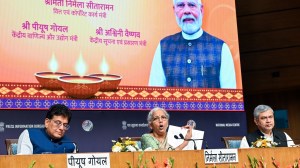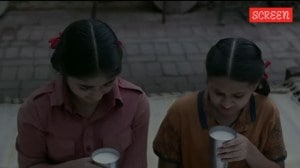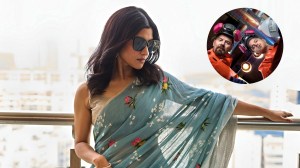Switching Tracks
Once when asked why he had stopped signing and dating his works upfront, M F Husain said, ‘‘People should know this is a painting ...

|
Sudarshan Shetty’s work briefly went from the usual still-life in Paper Moon (above) to critique the glitzy images of prone women in A Brisk Walk Makes You Feel Good (below)
|
|
|
Once when asked why he had stopped signing and dating his works upfront, M F Husain said, ‘‘People should know this is a painting by Maqbool Fida Husain by just looking at it!’’
Given that the market is known to have its rip-offs and fakes, the artist signs discreetly behind the canvas. However the sentiment remains the same—his style is his signature.
What then if the style shifts? When an abstract made by the same hands confronts viewers, including the gallerist Dadiba Pundole of Mumbai’s Pundole Art Gallery, leaving them surprised? ‘‘When I told Husain about the show, I had no idea that he would come up with an abstract work. I was really surprised, pleasantly though,’’ says Pundole.
Ask Husain why he’s experimenting with styles, and he dismisses the question with an ‘‘it’s a technical thing that people won’t understand’’.
Deja vu! For, Virendra Kumar Jain of Kumar Gallery in Delhi recalls how Husain had tried his hand at abstracts in the 1960s, only to go back to figurative work later. ‘‘He was genuinely experimenting but couldn’t sustain that genre,’’ says Jain.
One may wonder why an artist spends years evolving a style in the first place then. Geetha Mehra of Mumbai’s Sakshi Art Gallery has an explanation. ‘‘The success of any artist is to be able to arrive at a distinctive style, and recognisably his. If there is no distinct stamp then what remains is mere picture-making.’’
Laxman Shreshtha points out why the journey never ends: ‘‘It’s only after the struggle of finding himself that an artist arrives at a style that he can call his own. The quest, however, continues, for he would want to experiment.” In Shreshtha’s case, he introduced other elements, like geometric forms. “It marked a maturing of my style,’’ says the artist, whose recent show at Mumbai’s Jehangir Art Gallery displayed a distinctively different body of work. Shreshtha also used white after two decades.
Sometimes, it’s not just the maturing of a style but the desire to be somewhat maverick that drives an artist to play with the boundaries. Anjolie Ela Menon is a classic case.
Veteran artist Satish Gujral believes that some changes are actually sub-conscious. ‘‘The role of the sub-conscious is played by the change in an artist’s emotional moods and tastes. In my case, there has been no one stage,’’ says Gujral, who has gone through multiple shifts in styles and mediums—from architecture to painting. Though he dabbled in architecture very briefly, his contribution, like the design for the Belgian Embassy in Delhi, has been significant.
The temperament of the artist plays a large role as well. While an Edward Monet or a Sayed Haiderali Raza may spend years painting Water Lilies or the Bindu, a Picasso or Husain can fill up the whole of the National Gallery of Modern Art, just with their stylistic shifts.
While most gallerists like Mehra, Apparao and Kekoo Gandhy of Chemould Gallery (Mumbai) will support an artist’s stylistic shift as it’s a relationship of mutual respect, Gandhy’s clear about one thing: ‘‘It should have the base of creativity, and come from the heart. Otherwise one regards it as a gimmick.’’
|
||||
Mehra points out another reality: ‘‘Most artists make a judicious mix between experimentation and saleable works, for certainly he/she wants to be collected.’’
Not all experiments or shifts have been greeted with open arms, though. When Delhi-based artist Anupam Sud first made her shift in the ’80s from abstracts to detailed figuratives, ‘‘people said things like ‘if nothing else, your technique is very good’. It was insulting.’’ More recently, Shreshtha experienced a scenario where one of his regular collectors did not take too well to his large white-based canvases.
‘‘I continue to paint large canvases even though everyone screams ‘where do I put it?’ True collectors will find a way to accommodate me. But sincere people like senior art aficionado Bill Chowdhary (a Mumbai-based collector who has been collecting since the late V S Gaitonde was in his prime) are hard to come by,’’ Shreshtha rues.
New Media artist Baiju Parthan observes, ‘‘Collectors often prefer a particular period or style in an artist’s trajectory. There are some who prefer my earlier computer-based work, but then there are others who go only for my recent works.’’ Parthan’s last reflected a photo-realistic venture.
Post-modernist Riyas Komu
received a very good response to his charcoal sculpture displayed alongside his photo-realistic paintings in the January show (at Sakshi),‘Unconditional’. Many actually preferred his sculpture to his paintings. But Komu also believes that in today’s post-modern era, where all sorts of options are available to artists, ‘‘the notion of style is a very transient one’’.
Komu points out that today, post-modern painters like Atul Dodiya and Shibu Natesan and painter-turned-installation artist Sudarshan Shetty can enjoy their shifts of experimenting with semi-installation, photo-realism and avant garde installation, respectively, mainly because: ‘‘The current generation of artists has a kind of freedom because our seniors, like Tyeb Mehta and Akbar Padamsee, have laid a strong foundation. It is important that they spend so many years building it.’’
(With inputs from Shailaja Tripathi in New Delhi)



- 01
- 02
- 03
- 04
- 05




























